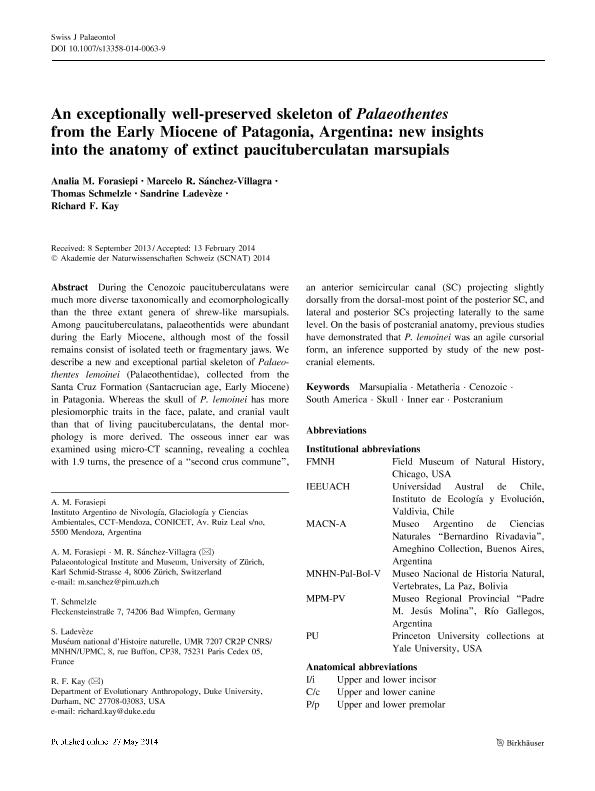Artículo
An exceptionally well-preserved skeleton of Palaeothentes from the Early Miocene of Patagonia, Argentina: new insights into the anatomy of extinct paucituberculatan marsupials
Forasiepi, Analia Marta ; Sánchez Villagra, Marcelo R.; Schmelzle, Thomas; Ladeveze, Sandrine; Kay, Richard F.
; Sánchez Villagra, Marcelo R.; Schmelzle, Thomas; Ladeveze, Sandrine; Kay, Richard F.
 ; Sánchez Villagra, Marcelo R.; Schmelzle, Thomas; Ladeveze, Sandrine; Kay, Richard F.
; Sánchez Villagra, Marcelo R.; Schmelzle, Thomas; Ladeveze, Sandrine; Kay, Richard F.
Fecha de publicación:
05/2014
Editorial:
Springer
Revista:
Swiss Journal of Palaeontology
ISSN:
1664-2376
e-ISSN:
1664-2384
Idioma:
Inglés
Tipo de recurso:
Artículo publicado
Clasificación temática:
Resumen
During the Cenozoic paucituberculatans were much more diverse taxonomically and ecomorphologically than the three extant genera of shrew-like marsupials. Among paucituberculatans, palaeothentids were abundant during the Early Miocene, although most of the fossil remains consist of isolated teeth or fragmentary jaws. We describe a new and exceptional partial skeleton of Palaeothentes lemoinei (Palaeothentidae), collected from the Santa Cruz Formation (Santacrucian age, Early Miocene) in Patagonia. Whereas the skull of P. lemoinei has more plesiomorphic traits in the face, palate, and cranial vault than that of living paucituberculatans, the dental morphology is more derived. The osseous inner ear was examined using micro-CT scanning, revealing a cochlea with 1.9 turns, the presence of a “second crus commune”, an anterior semicircular canal (SC) projecting slightly dorsally from the dorsal-most point of the posterior SC, and lateral and posterior SCs projecting laterally to the same level. On the basis of postcranial anatomy, previous studies have demonstrated that P. lemoinei was an agile cursorial form, an inference supported by study of the new postcranial elements.
Palabras clave:
Marsupialia
,
Cenozoic
,
Skull
,
Inner Ear
Archivos asociados
Licencia
Identificadores
Colecciones
Articulos(IANIGLA)
Articulos de INST. ARG. DE NIVOLOGIA, GLACIOLOGIA Y CS. AMBIENT
Articulos de INST. ARG. DE NIVOLOGIA, GLACIOLOGIA Y CS. AMBIENT
Citación
Forasiepi, Analia Marta; Sánchez Villagra, Marcelo R.; Schmelzle, Thomas; Ladeveze, Sandrine; Kay, Richard F.; An exceptionally well-preserved skeleton of Palaeothentes from the Early Miocene of Patagonia, Argentina: new insights into the anatomy of extinct paucituberculatan marsupials; Springer; Swiss Journal of Palaeontology; 133; 1; 5-2014; 1-21
Compartir
Altmétricas



